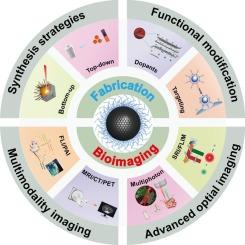The application of carbon dot-based nanoprobes in advanced optical imaging and multimodality imaging
IF 23.5
1区 化学
Q1 CHEMISTRY, INORGANIC & NUCLEAR
引用次数: 0
Abstract
Carbon dots (CDs), as versatile fluorescent nanomaterials, demonstrate immense potential for revolutionizing bioimaging due to their facile synthesis, excellent photophysical properties, biocompatibility, and tunable surface chemistry. Their high quantum yield, superior photostability, and tunable emission wavelengths make them ideal materials for highly sensitive fluorescence imaging, including confocal microscopy and super-resolution imaging techniques, enabling detailed subcellular visualization. Their unique fluorescence lifetime characteristics also facilitate fluorescence lifetime imaging microscopy (FLIM) for sensing microenvironments and multiplexing. Furthermore, CDs excel in multiphoton excitation microscopy (MPEM), utilizing their large multiphoton absorption cross-sections for deep-tissue imaging with reduced background and photodamage. Crucially, the ease of functionalizing CDs allows for their integration with other contrast agents (e.g., magnetic nanoparticles, radionuclides, photosensitizers), enabling the construction of sophisticated multimodal nanoprobes. These probes synergistically combine the high sensitivity and resolution of optical imaging with the deep penetration capabilities of techniques such as magnetic resonance imaging (MRI), positron emission tomography (PET), computed tomography (CT), and photoacoustic imaging (PAI). Such multimodal systems provide complementary anatomical, functional, and molecular information, significantly enhancing diagnostic accuracy and enabling real-time image-guided interventions. This review focuses on the applications of CD-based nanoprobes in cutting-edge advanced optical imaging and multimodality imaging technologies. It begins with a brief introduction to mainstream synthesis methods and functional modifications of current CDs. Then, based on the current research landscape, it details the applications and principles of CDs in advanced optical imaging and multimodal imaging. Moreover, we have made a brief summary of the biosafety of carbon dots in biological applications. Finally, it outlines their challenges and prospects in biomedical applications.

碳点纳米探针在先进光学成像和多模态成像中的应用
碳点(cd)作为多功能荧光纳米材料,由于其易于合成、优异的光物理特性、生物相容性和可调的表面化学特性,显示出巨大的生物成像革命潜力。它们的高量子产率、优越的光稳定性和可调谐的发射波长使它们成为高灵敏度荧光成像的理想材料,包括共聚焦显微镜和超分辨率成像技术,实现详细的亚细胞可视化。其独特的荧光寿命特性也有利于荧光寿命成像显微镜(FLIM)的传感微环境和多路复用。此外,CDs在多光子激发显微镜(MPEM)中表现优异,利用其大的多光子吸收截面进行深层组织成像,减少背景和光损伤。至关重要的是,功能化CDs的易用性允许它们与其他造影剂(例如,磁性纳米颗粒,放射性核素,光敏剂)集成,从而能够构建复杂的多模态纳米探针。这些探针将光学成像的高灵敏度和高分辨率与磁共振成像(MRI)、正电子发射断层扫描(PET)、计算机断层扫描(CT)和光声成像(PAI)等技术的深度穿透能力协同结合。这种多模式系统提供了互补的解剖、功能和分子信息,显著提高了诊断准确性,并使实时图像引导干预成为可能。本文综述了基于cd的纳米探针在先进光学成像和多模态成像技术中的应用。首先简要介绍了当前CDs的主流合成方法和功能修饰。然后,根据目前的研究现状,详细介绍了CDs在先进光学成像和多模态成像中的应用和原理。并对碳点在生物领域应用的生物安全性作了简要综述。最后,概述了它们在生物医学应用中的挑战和前景。
本文章由计算机程序翻译,如有差异,请以英文原文为准。
求助全文
约1分钟内获得全文
求助全文
来源期刊

Coordination Chemistry Reviews
化学-无机化学与核化学
CiteScore
34.30
自引率
5.30%
发文量
457
审稿时长
54 days
期刊介绍:
Coordination Chemistry Reviews offers rapid publication of review articles on current and significant topics in coordination chemistry, encompassing organometallic, supramolecular, theoretical, and bioinorganic chemistry. It also covers catalysis, materials chemistry, and metal-organic frameworks from a coordination chemistry perspective. Reviews summarize recent developments or discuss specific techniques, welcoming contributions from both established and emerging researchers.
The journal releases special issues on timely subjects, including those featuring contributions from specific regions or conferences. Occasional full-length book articles are also featured. Additionally, special volumes cover annual reviews of main group chemistry, transition metal group chemistry, and organometallic chemistry. These comprehensive reviews are vital resources for those engaged in coordination chemistry, further establishing Coordination Chemistry Reviews as a hub for insightful surveys in inorganic and physical inorganic chemistry.
 求助内容:
求助内容: 应助结果提醒方式:
应助结果提醒方式:


